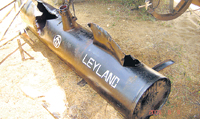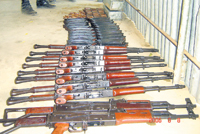 |
||||||||||||
| |
||||||||||||
|
Eelam war IV rages on several fronts
Plans by the Liberation Tigers of Tamil Eelam (LTTE) to lay siege on the Jaffna peninsula began to unravel on Friday evening as Eelam War IV raged for a second successive week. The most disturbing development came when guerrillas directed artillery fire at the Security Forces Headquarters (SFHQ) in Jaffna. It fell on many places including the runway at the Palaly Air Force base located in the same complex. A Bell 212 helicopter was damaged. Military officials said the guerrillas were firing 130 mm artillery from the general area of Kalmunai Point and southwards from Pooneryn.
All military and commercial flights to Palaly were suspended yesterday. This is until such time the authorities carry out a full threat assessment and formulate counter measures. The fact that the guerrillas, like during the attacks on Palaly in 1999, were using long range artillery is a matter for serious concern. It prevents fixed wing aircraft from taking troops or fresh food supplies. Moreover, evacuation of casualties is also hampered. However, the area is accessible by helicopter but the threat of guerrilla Surface-to-Air Missiles would have to be borne in mind. Air Force pilots braved these threats yesterday to fly Mi17 troop transport helicopters with full complements of commandos from the east.
The A-9 Kandy-Jaffna highway, the only road link to the Jaffna peninsula, was shut yesterday. This route is the main form of food transport to civilians in the peninsula. Jaffna also came under a curfew from 7 p.m. on Friday night. In the Wanni, the guerrillas ordered the closure of communication centres and decreed that civilians should not use mobile phones. These were intended to prevent the leak of information relating to their military activities. The pro-LTTE website Tamilnet claimed that a guerrilla aircraft flew over Palaly "firing rockets around 9.30 pm (on Friday)." Air Force officials flatly denied the claim. They said a Bell 212 helicopter was damaged due to artillery fire. Also damaged was an aviation fuel bowser. However, military officials in the north whom I spoke to said they heard the engine noise of a fixed wing aircraft but added they saw no firing. One heard it over Muhamalai whilst another near the SFHQ in Jaffna. Whilst pounding Palaly with artillery fire, guerrillas simultaneously directed artillery barrages at the Eastern Naval Area Headquarters at the Dockyard in Trincomalee. One sailor was killed and another was wounded. The first such artillery attack at the Dockyard since the advent of the separatist war came on August 1 and left six sailors dead. Eighteen others were wounded. There was a disturbing difference in this artillery attack past midnight on Friday. It was directed at several other locations besides the Eastern Naval Area Headquarters. A few fell at the Prima flour milling complex at China Bay, the Air Force base and the immediate environs. Lorries had queued up outside the gates to load flour. One civilian driver was killed on the spot and seven lorries were damaged. At the Air Force base one officer and an airman received minor injuries. The artillery barrage continued till the early hours yesterday. The LTTE's inability to seize and hold Mutur and other adjoining areas, as part of their grand design to place a siege on Jaffna, did not materialize last week. Security forces were able to evict them from the positions they held for almost two days. Yet, they succeeded in driving out more than 40,000 Muslims in the area. If they have thus ensured that security forces and police will have to deal with a largely hostile population on the ground, they demonstrated on Friday that the capacity they built during the ceasefire to direct artillery and mortar attacks on the Dockyard, and now on targets in China Bay, are intact. This is despite many a warning received by then President Chandrika Bandaranaike Kumaratunga when she was in office. She first acknowledged the threat but later denied that it existed. Nothing was done. Sad enough, some troops have paid with their lives and others have been injured. Yet others are now in harm's way. Besides Palaly, the guerrillas launched artillery and mortar attacks on several security forces positions south of the peninsula. Under cover of this, guerrillas advanced to attack bunkers at the defended localities. At one point near Kilali, troops fell back and some twenty bunkers came to be occupied by them. Near the Muhamalai entry-exit point, six bunkers were thus occupied. In the bitter gun battles that followed six soldiers were killed and 20 wounded. The Navy thwarted an attempt by a flotilla of Sea Tiger boats to land at Vettilaikerny in the north east. Yesterday, troops fought back and drove the guerrillas out of all positions. They could not occupy some six bunkers since they have been destroyed. They were busy reconstructing them. Three officers, 29 soldiers and two sailors were killed. A further 72 were wounded. Battles were still raging in some areas as this edition went to press. That included fighting in the seas off Mandaitivu and in Kayts where troops encountered guerrillas who had infiltrated. The Army said they killed more than 100 guerrillas independent verification is not possible. There were reports yesterday that groups of guerrillas have infiltrated Point Pedro and Kayts. There were also reports of some groups moving in the Kiliali lagoon where troops on Friday night destroyed at least four of their boats. On Friday night the clandestine Voice of Tigers (VoT) radio station and their TV network Nitharshanam repeatedly broadcast an appeal from the LTTE. They wanted civilians living closer to military camps in the Thenmaratchy sector to leave their homes and proceed to areas a kilometre away. Among the villages to which the appeal has been specifically made are Kilaly, Pullopalai, Manduvil, Eluthumaduval, Varani, Katchchai, Meesalai and Kodikamam. The move indicated that the guerrillas were planning more attacks on security forces positions. On his return from Kandy yesterday, President Mahinda Rajapaksa drove to the Joint Operations Headquarters (JOH) to receiving a full briefing on developments in the Jaffna peninsula. On hand with the military top brass was Chief of Defence Staff Air Chief Marshal Donald Perera. This morning President Rajapaksa will meet representatives of political parties supporting the Government including the Janatha Vimukthi Peramuna (JVP) and the Jathika Hela Urumaya (JHU). Later in the day he also scheduled to meet Sri Lanka Muslim Congress leader Rauf Hakeem. The scene of heavy fighting with the beginning of Eelam War IV in the east shifted to the north on Friday. It came in the immediate aftermath of Air Force raids on an LTTE base in Tharavai, north west of Batticaloa. Head of LTTE's Peace Secretariat Seevaratnam Prabagaran alias Pulithevan admitted that their cadres suffered heavy casualties but declined to divulge details. He told media outlets in Colombo on the telephone from Kilinochchi "we have been pushed beyond all limits of tolerance. The Government only wants a military solution." According to other sources over 50 guerrillas were killed. Tiger guerrillas appear to be gaining considerable propaganda mileage. On Friday their Military Spokesman Irasiah Ilantheriyan accused Security Forces of launching artillery attacks and beginning a troop movement towards Elephant Pass. He said thousands of civilians were fleeing towards Kilinochchi. In reality, this was how the LTTE set the stage for their offensive action against the security Forces on Friday night. In marked contrast, the Government's media responses were woefully inadequate and misleading. It tended to create the feeling that President Rajapaksa's government had to cope with two enemies, one outside and one within. Soon after the killings of 17 aid workers in Mutur belonging to Action la Contre Faim (Action Against Hunger), Defence Spokesman Keheliya Rambukwella was quoted as telling CNN that the LTTE was responsible for the killings. He said last Monday that the Government had evidence in the form of eyewitness accounts. Following repeated CNN broadcasts, former US President Bill Clinton was among those who wanted the Government to "do everything possible to apprehend the perpetrators of this crime and to bring them to justice." That was on the same day. However, on Tuesday the Media Centre for National Security issued a press release announcing that a special team of Police Officers under a DIG has been deployed by the Inspector General of Police (IGP) to investigate into the incident and report. The concluding paragraph in the press release said: "Commenting on the incident, the IGP stated that, there is no evidence (sic) whatsoever is available at present; however, the police will be able to submit detailed report subsequent to magisterial post mortems." This assertion is from the same media centre which is under Mr. Rambukwella's charge. How come he spoke of evidence from eyewitnesses when the country's police chief says "no evidence whatsoever is available." That is bad enough. There is something worse. Within half an hour of the issue of this press release, the Media Centre for National Security put out another press release. This is what the last paragraph said "The Government has stated that it will take stern action at the earliest against anyone involved as responsible, irrespective of their position for the death of these innocent civilians based on the findings of the inquiry." The reference to any one involved "irrespective of their position" no doubt raises a significant question. Does that, though perhaps unintended, mean someone within the Government or the security establishment? Such a statement has got into an official news release. But, the question of anyone "irrespective of their position" as far as the LTTE is concerned does not arise. How much credibility would any discerning Sri Lankan or those in the outside world would have in the Media Centre for National Security and its official pronouncements? It is no different than the similar propaganda outfits of the past that did more damage than good to successive Governments. Unfortunately, Government leaders never realize this until they are out of office. Another propaganda victory for the LTTE came with claims that they had opened the Mavil Aru anicut on their own for "humanitarian reasons." This, they claimed, was without any pre conditions. Many international media organizations raised the question - why did the Government continue to pursue the military campaign when the LTTE has so graciously opened the anicut? The truth, The Sunday Times learnt, was different. A high ranking military source said the security forces bombed the Mavil Aru anicut. It was so precisely done that water began flowing thereafter. The source spoke on grounds of anonymity since they are debarred from speaking to the media. High ranking Government officials declined comment when asked about this bombing. This is why the military offensive to seize control of Mavil Aru anicut that began on July 28, still continues. A Situation Report delivered to selected VIPs and military top brass on Thursday morning (August 10) has this to say: "Troops of the Special Forces and 8th Gemunu Watch launched assault on the Western anicut. Troops cleared Western anicut and progressed towards Eastern anicut bund road junction - 50 metres short of the Eastern anicut. "Heavy indirect fire encountered. Due to this, troops held back to the Western anicut. Troops holding Western anicut and consolidating. "Due to this incident 9 soldiers were killed in action. Five officers and 60 soldiers injured." There is a distance of six kilometres from the bund road to the Mavil Aru head sluice gates as shown in the map on page 11 and details of the anicuts in the area. Security sources said that the 15-day-long military operation will continue until the area is brought under their control. Up to now 36 soldiers including two officers have been killed in this operation. With Eelam War IV now on, the LTTE cadres have some three and half months to set the stage. That is for their leader, Velupillai Prabhkaran to formally pronounce the next course of action in his Maveerar (Great Heroes) Day speech in November. Last year, he said, "…..President Rajapaksa is considered a realist committed to pragmatic policies, we wish to find out, first of all, how he is going to handle the peace process and whether he will offer justice to our people. We have, therefore, decided to wait and observe, for sometime, his political maneuvres and actions. "Our people have lost patience, hope and reached the brink of utter frustration. They are not prepared to be tolerant any longer. The new government should come forward soon with a reasonable political framework that will satisfy the political aspirations of the Tamil people. This is our urgent and final appeal. "If the new government rejects our urgent appeal, we will, next year, in solidarity with our people, intensify our struggle for self-determination, our struggle for national liberation to establish self government in our homeland." A debate on who triggered off Eelam War IV is already raging. There is no doubt the LTTE became militarily stronger exploiting the ceasefire to recruit and re-arm. The absence of proper checks and balances in the defence establishment has caused serious problems and forced the government to veer off course. Such lapses are unfolding as the nation faces a mounting guerrilla threat. But, as pointed out before, President Rajapaksa
inherited the legacies left behind by the blunders of previous political
leaders. To that extent, he has an unenviable task in putting things
right.
|
||||||||||||
Copyright © 2001 Wijeya Newspapers
Ltd. All rights reserved. |
||||||||||||
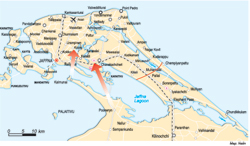
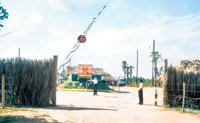
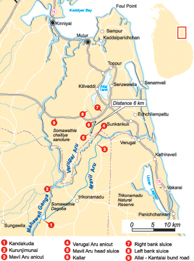 The
Mavil Aru anicut has become the cynosure of both international
and Sri Lankan attention in the past few weeks. Here is a
brief account of its history and location.
The
Mavil Aru anicut has become the cynosure of both international
and Sri Lankan attention in the past few weeks. Here is a
brief account of its history and location.